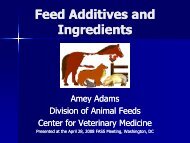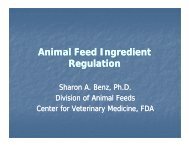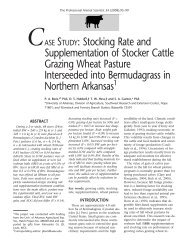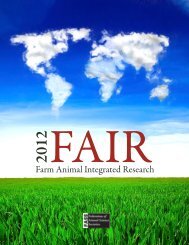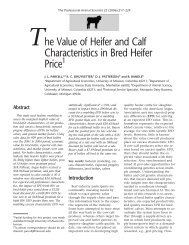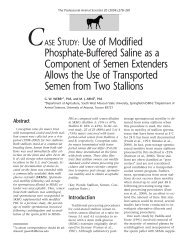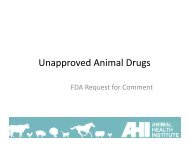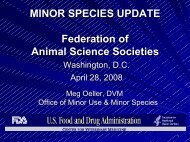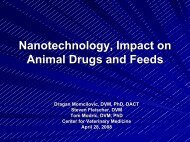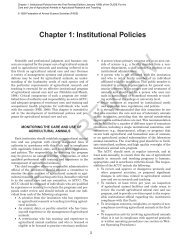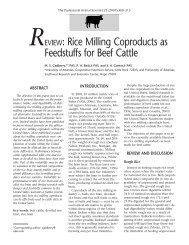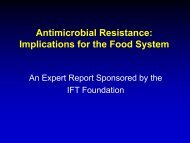Fair 2002 - Federation of Animal Science Societies
Fair 2002 - Federation of Animal Science Societies
Fair 2002 - Federation of Animal Science Societies
You also want an ePaper? Increase the reach of your titles
YUMPU automatically turns print PDFs into web optimized ePapers that Google loves.
<strong>Animal</strong> Products for the next Millennium<br />
–An Agenda for Research and Education–<br />
Coordinating Organizations:<br />
<strong>Animal</strong> Agriculture Coalition<br />
and<br />
<strong>Federation</strong> <strong>of</strong> <strong>Animal</strong> <strong>Science</strong> <strong>Societies</strong><br />
To order additional copies or to obtain more information, contact<br />
FASS<br />
(<strong>Federation</strong> <strong>of</strong> <strong>Animal</strong> <strong>Science</strong> <strong>Societies</strong>)<br />
1111 N. Dunlap Avenue<br />
Savoy, IL 61874<br />
(217) 356-3182<br />
FAX: (217) 398-4119
Steering Committee Organizations<br />
American Dairy Products Institute<br />
American Dairy <strong>Science</strong> Association<br />
American Farm Bureau <strong>Federation</strong><br />
American Feed Industry Association<br />
American Horse Council<br />
American Meat Institute<br />
American Meat <strong>Science</strong> Association<br />
American Sheep Industry Association<br />
American Society <strong>of</strong> Agronomy<br />
American Society <strong>of</strong> <strong>Animal</strong> <strong>Science</strong><br />
American Society for Nutritional <strong>Science</strong>s<br />
American Veterinary Medical Association<br />
<strong>Animal</strong> Health Institute<br />
Association <strong>of</strong> American Veterinary Medical Colleges<br />
Center for Veterinary Medicine<br />
Council for Agricultural <strong>Science</strong> and Technology<br />
Dairy Management, Inc.<br />
Experiment Station Committee on Organization and Policy<br />
Extension Committee on Organization and Policy<br />
Holstein Association USA, Inc.<br />
Institute <strong>of</strong> Food Technologists<br />
Livestock Conservation Institute<br />
National Broiler Council<br />
National Cattlemen’s Beef Association<br />
National Meat Association<br />
National Milk Producers <strong>Federation</strong><br />
National Pork Producers Council<br />
National Turkey <strong>Federation</strong><br />
Poultry <strong>Science</strong> Association<br />
US Poultry & Egg Association<br />
USDA - Agricultural Research Service<br />
USDA - <strong>Animal</strong> and Plant Health Inspection Service<br />
USDA - Cooperative State Research, Education,<br />
and Extension Service<br />
USDA - Economic Research Service<br />
USDA - Food Safety and Inspection Service<br />
Sponsors<br />
American Farm Bureau <strong>Federation</strong><br />
American Feed Industry Association<br />
Holstein Foundation, Inc.<br />
National Cattlemen’s Beef Association<br />
National Milk Producers <strong>Federation</strong><br />
National Pork Producers Council<br />
USDA - Agricultural Research Service<br />
USDA - Cooperative State Research, Education,<br />
and Extension Service<br />
Prepared by FAIR <strong>2002</strong> Writers Committee<br />
Chris Sigurdson, Chair<br />
Purdue University<br />
Maynard Hogberg<br />
Michigan State University<br />
Susan Lamont<br />
Iowa State University<br />
Les Hansen<br />
University <strong>of</strong> Minnesota<br />
Jimmy Keeton<br />
Texas A&M University<br />
Copy Editor<br />
Amy Kemp<br />
<strong>Federation</strong> <strong>of</strong> <strong>Animal</strong> <strong>Science</strong> <strong>Societies</strong><br />
Design<br />
Rod Roberts<br />
Roberts Design Company<br />
Photo Credits<br />
ARS Image Gallery<br />
©1999 www.farmphoto.com<br />
Other Publications<br />
Synopsis. “<strong>Animal</strong> Products for the Next Millennium<br />
— An Agenda for Research and Education.”<br />
Two-page brochure.<br />
Proceedings <strong>of</strong> the Food <strong>Animal</strong> Integrated Research <strong>2002</strong><br />
Symposium on Food <strong>Animal</strong> Research Priorities.<br />
This report contains the formal presentations<br />
made and includes identification <strong>of</strong> the issues that are important<br />
to the competitiveness and sustainability <strong>of</strong> food and fiber<br />
production from animals.<br />
F<br />
AIR <strong>2002</strong> is the outcome <strong>of</strong> the second<br />
national conclave to establish consensus on<br />
animal agriculture research and education<br />
priorities for the 21st century. More than 250<br />
leading animal scientists, farmers, ranchers,<br />
environmentalists, animal welfare proponents,<br />
commodity group representatives, government<br />
staff, rural advocates, and agribusiness and food<br />
service representatives gathered to determine<br />
the most pressing research and education needs<br />
<strong>of</strong> the animal industry.<br />
The science behind animal agriculture affects<br />
America’s international trade balance, our<br />
environment, our neighbors, local economies,<br />
and us as individuals. Competitive farmers and<br />
ranchers with the right knowledge and tools<br />
can ensure that livestock, dairy, and poultry<br />
enterprises thrive; consumers get safe and<br />
nutritious food; and wildlife benefit from<br />
improved animal health and enhanced environmental<br />
stewardship. Food animals fare better in<br />
the care <strong>of</strong> knowledgeable producers and<br />
processors, and communities reap financial<br />
rewards from food-processing industries.<br />
Gains such as these require public investments<br />
in research and education that, in turn, fuel the<br />
creation <strong>of</strong> industries and export pr<strong>of</strong>its that<br />
sustain communities and rural economies<br />
across the country. Keeping that edge will<br />
require a clear vision for the future and a<br />
strategic plan for research investments to<br />
attain the next generation <strong>of</strong> innovations.<br />
Six goals became the foundation for FAIR<br />
<strong>2002</strong>’s research priorities and objectives, the<br />
necessary steps to ensure that we raise the best<br />
quality animal products in ways that are<br />
economically competitive, environmentally<br />
friendly, and socially acceptable. They are<br />
• Strengthen Global Competitiveness:<br />
Develop the systems needed to keep<br />
American animal agriculture competitive<br />
in the global market<br />
• Enhance Human Nutrition:<br />
Improve animal food products to help<br />
people live better<br />
• Protect <strong>Animal</strong> Health:<br />
Develop strategies and technologies<br />
to prevent, diagnose, and treat<br />
animal diseases<br />
• Improve Food Safety and<br />
Public Health:<br />
Safeguard public health and reduce<br />
the risk <strong>of</strong> food-borne diseases<br />
• Ensure Environmental Quality:<br />
Devise animal production and<br />
processing systems that sustain<br />
or improve the environment<br />
• Promote <strong>Animal</strong> Well-Being:<br />
Enhance animal well-being throughout<br />
the food production cycle.<br />
These goals address the emerging issues and<br />
competitive gaps in a national strategy to<br />
keep the American animal industry on top.<br />
Tomorrow’s problems cannot be solved with<br />
yesterday’s thinking. Success will require<br />
continued public investment in U.S. academic<br />
institutions and government laboratories whose<br />
record <strong>of</strong> achievement is the envy <strong>of</strong> the world.
Strengthen Global Competitiveness:<br />
Develop the systems needed to keep American animal<br />
agriculture competitive in the global market<br />
Committees, Sponsors, and Credits<br />
M<br />
ost American livestock producers wage<br />
an unrelenting war on cost. While other<br />
countries can exploit cheaper labor or<br />
more relaxed environmental standards,<br />
U.S. producers are engaged<br />
in a constant struggle to reduce<br />
expenses and increase<br />
productivity and quality.<br />
The global market rewards<br />
high quality, low price providers,<br />
which the U.S. has been able to<br />
supply. But, we cannot rest on<br />
past laurels. Canadian and Brazilian pork<br />
producers are mimicking American production<br />
systems and reaping the benefits. Australian<br />
cattle producers overtook the Americans in<br />
the late 1990s, producing beef for $.28 less<br />
per pound than U.S. producers.<br />
Reclaiming market dominance will require new<br />
technologies—many at the level <strong>of</strong> the genome.<br />
It also will take new approaches to the raising<br />
<strong>of</strong> animals and the development <strong>of</strong> a knowledge<br />
base to create prosperous animal agriculture<br />
systems <strong>of</strong> the future.<br />
Objective 1<br />
Enhance production efficiency and<br />
economic strategies at the farm and ranch level<br />
A systems approach <strong>of</strong> verified management<br />
techniques combined with new sensor and<br />
information technology promises great<br />
opportunities for livestock production.<br />
Monitoring and measuring<br />
technology allows centralized<br />
supervision <strong>of</strong> animal health,<br />
production efficiency, and<br />
environmental impacts.<br />
The field <strong>of</strong> animal genomics<br />
holds great promise for improving<br />
animal and human health,<br />
food safety, and animal production. Little is<br />
known about the genetic maps <strong>of</strong> animals—<br />
valuable information that could be used to<br />
improve accuracy <strong>of</strong> selection and to characterize<br />
valuable germplasm populations for<br />
safekeeping and future applications.<br />
Objective 2<br />
Position producers and processors <strong>of</strong> animal<br />
products to succeed in a global market<br />
Export markets for animal products provide an<br />
important opportunity for rural communities<br />
to participate in the global economy. A single<br />
percentage growth in income overseas corresponds<br />
with a 1% increase in the consumption<br />
<strong>of</strong> meat, milk, and eggs.<br />
FAIR <strong>2002</strong> Executive Planning Committee<br />
Elton Aberle, Chair<br />
University <strong>of</strong> Wisconsin<br />
Robert Barnes<br />
Tri-<strong>Societies</strong><br />
Mark Cook<br />
Poultry <strong>Science</strong> Association<br />
Lester Crawford<br />
Georgetown Center for Food and<br />
Nutrition Policy<br />
Kirk Ferrell<br />
National Pork Producers Council<br />
Stanley Gilliland<br />
<strong>Federation</strong> <strong>of</strong> <strong>Animal</strong> <strong>Science</strong> <strong>Societies</strong><br />
Alice Hurlbert<br />
National Turkey <strong>Federation</strong><br />
Curt Mann<br />
Association <strong>of</strong> American Veterinary<br />
Medical Colleges<br />
Kenneth Olson<br />
American Farm Bureau <strong>Federation</strong><br />
Steve Pretanik<br />
National Broiler Council<br />
Gary Weber<br />
National Cattlemen’s Beef Association<br />
Robert Zimbelman<br />
<strong>Federation</strong> <strong>of</strong> <strong>Animal</strong> <strong>Science</strong> <strong>Societies</strong><br />
FAIR <strong>2002</strong> Program Committee<br />
James Males, Chair<br />
Oregon State University<br />
James Denton<br />
University <strong>of</strong> Arkansas<br />
Adele Douglas<br />
American Humane Association<br />
Velmer Green<br />
Dairy Producer, Elsei, MI<br />
Colin Kaltenbach<br />
University <strong>of</strong> Arizona<br />
Dennis Keeney<br />
Leopold Center for Sustainable Agriculture<br />
Lonnie King<br />
Michigan State University<br />
Mohammad Koohmaraie<br />
USDA, ARS, USMARC<br />
Jack Maddux<br />
Maddux Cattle Company, Wauneta, NE<br />
Dennis Marple<br />
Iowa State University<br />
David Meeker<br />
The Ohio State University<br />
Larry Miller<br />
USDA, CSREES<br />
Ken Odde<br />
Pfizer <strong>Animal</strong> Health<br />
Caird Rexroad<br />
USDA - ARS<br />
On today’s farms, pennies saved become pr<strong>of</strong>its<br />
earned. Research on different farming systems<br />
is needed to achieve efficiencies in reproduction,<br />
rate <strong>of</strong> gain, and handling. Once created<br />
in the lab and research barn, these new methods<br />
will need to be tested in actual production<br />
systems and in commercial trials.<br />
To market internationally, however, animal<br />
producers will need to make informed<br />
decisions to accommodate the demands <strong>of</strong><br />
competitive global markets. They need to know<br />
what those markets will buy and in what form.<br />
Robert Zimbelman<br />
<strong>Federation</strong> <strong>of</strong> <strong>Animal</strong> <strong>Science</strong> <strong>Societies</strong>
Enhance Human Nutrition:<br />
Improve animal food products to help people live better<br />
A<br />
mericans like to eat meat. The U.S. Department<br />
<strong>of</strong> Agriculture reports that consumption<br />
<strong>of</strong> red meat, poultry, and fish in 1996 was 191<br />
lbs. per person, only 2 lbs. less than the record<br />
set in 1994.<br />
Much is known about the role <strong>of</strong><br />
animal products in a healthy diet.<br />
Children’s learning and intellectual<br />
development have been directly<br />
linked to the benefits <strong>of</strong> eating the<br />
protein found in meat and eggs.<br />
Young women need extra amounts<br />
<strong>of</strong> calcium early to <strong>of</strong>fset osteoporosis later in<br />
life. Milk products have been documented as<br />
the best source <strong>of</strong> calcium for growing girls,<br />
helping them dodge a disease that costs the<br />
U.S. $13 billion and widespread misery in<br />
crippling injuries every year. Heavy exercisers<br />
need dietary iron. Older Americans with lesser<br />
appetites appreciate the large amounts <strong>of</strong> zinc<br />
and other micronutrients concentrated in small<br />
portions <strong>of</strong> beef and chicken.<br />
New research suggests that some compounds<br />
in animal products not only fuel the body, but<br />
also protect it from disease. Conjugated linoleic<br />
acid, CLA, a compound found in meat and<br />
dairy products, has been found to prevent<br />
some skin cancers and slow the onset <strong>of</strong> adult<br />
diabetes in laboratory tests. Eggs with added<br />
Omega-3 fatty acids yield multiple benefits to<br />
health-conscious consumers. Those<br />
with compromised immune systems<br />
need the zinc, iron, and other<br />
elements found in chicken, beef,<br />
and pork.<br />
The more we learn about the relationships<br />
among human nutrition, health,<br />
and the meat, dairy, and egg products<br />
Americans love, the better we can help consumers<br />
make decisions to improve their lives.<br />
Objective 1<br />
Research the contributions <strong>of</strong> meat, eggs,<br />
and dairy products to healthy, balanced diets<br />
More research into the beneficial<br />
health effects <strong>of</strong> meat consumption,<br />
especially reduced-fat<br />
products, is needed to ensure<br />
that consumers are getting the<br />
right amounts <strong>of</strong> all nutrients,<br />
not just fewer calories. Additional<br />
work needs to be done<br />
on the analysis <strong>of</strong> animal-derived<br />
food products and the unique<br />
roles they play in the healthy<br />
development <strong>of</strong> men and<br />
women <strong>of</strong> all ages. Nutrition<br />
research at university and federal<br />
labs has become the touchstone<br />
for a public that is skeptical <strong>of</strong><br />
health claims on food and supplement products.<br />
It takes objective science to make a real difference<br />
in people’s diets.<br />
Objective 2<br />
Determine the impact <strong>of</strong> current and<br />
alternative production systems on animal<br />
well-being and food quality, including<br />
handling, transportation, and slaughter<br />
Sophisticated research into animal immune<br />
systems, neuroscience, human-animal interaction,<br />
stress biology, and endocrinology not only will<br />
endorse or rule out current practices, but will<br />
facilitate the design <strong>of</strong> new production systems<br />
and practices. How we raise animals in 50 years<br />
could be as radically different as contemporary<br />
systems are from those 50 years ago.<br />
Research also will answer questions that have<br />
surfaced only recently. Does the industry trend<br />
toward larger, more concentrated operations<br />
affect animal well-being? What should be done,<br />
and at what cost to the animal, the producer, and<br />
the public? For instance, animal health and food<br />
safety in free-range chickens may suffer from<br />
greater exposure to pathogens while other aspects<br />
<strong>of</strong> well-being may only be improved slightly.<br />
Early research also suggests that improvements<br />
in animal well-being can protect human health.<br />
Investments in animal well-being studies<br />
benefit people and animals.<br />
Objective 3<br />
Explore ethical issues in animal<br />
production and research<br />
Less than 2% <strong>of</strong> the U.S. population is involved<br />
in food production at the farm level.<br />
<strong>Science</strong> will help, but society will make the<br />
decisions about animal production and research.<br />
Ultimately, we believe that an informed<br />
public will make better decisions, but they<br />
must have the chance to learn.<br />
A credible education effort should include an<br />
accurate representation <strong>of</strong> public beliefs and<br />
values. Studies <strong>of</strong> public perceptions <strong>of</strong> animal<br />
production practices will guide educational<br />
efforts that should help both the public and<br />
animal industries.
Protect <strong>Animal</strong> Health:<br />
Develop strategies and technologies to prevent,<br />
diagnose, and treat animal diseases<br />
C<br />
urrent and emerging food animal diseases are<br />
estimated to cause losses totaling up to 18% <strong>of</strong><br />
the annual farm gate value <strong>of</strong> animal commodities,<br />
costing producers and the U.S. economy<br />
billions <strong>of</strong> dollars each year.<br />
This represents a major threat to<br />
animal production and hurts the<br />
competitiveness and pr<strong>of</strong>itability<br />
<strong>of</strong> U.S. animal agriculture.<br />
Recent years have seen the<br />
emergence <strong>of</strong> new animal<br />
pathogens. The prevalence <strong>of</strong><br />
international travel and trade<br />
has increased the potential for<br />
accidentally or deliberately<br />
introduced foreign infectious<br />
agents that would threaten the<br />
stability <strong>of</strong> the U.S. food supply<br />
and international trade. Advances<br />
in production systems<br />
have exposed more animals to illness. Other<br />
animal diseases have re-emerged as serious<br />
threats, as previous methods <strong>of</strong> control have<br />
lost their effectiveness.<br />
To protect the health <strong>of</strong> food animals and<br />
reduce the risks that those pathogens pose to<br />
our food supply and international<br />
trade, it is imperative that improved<br />
strategies and technologies be<br />
developed to prevent, diagnose, and<br />
treat animal diseases. Research will<br />
improve the safety net for both the<br />
animals and the public.<br />
Objective 1<br />
Detect and control animal diseases that<br />
threaten the food supply<br />
Our capability to respond to an outbreak <strong>of</strong><br />
animal disease will always be dependent on our<br />
ability to diagnose the cause swiftly, which<br />
requires more rapid and accurate diagnostic tools<br />
to help producers and veterinarians appropriately<br />
treat animals and improve biosecurity.<br />
Describing the structure <strong>of</strong><br />
microbial genomes will help<br />
develop diagnostic tools and<br />
help define how disease agents<br />
infect and damage host animals.<br />
Novel treatments depend on<br />
basic insight into animal and<br />
microbial genomes.<br />
To limit effectively the spread <strong>of</strong> disease agents to<br />
animals and from animals to humans, the basic<br />
factors important in disease transmissions must<br />
be understood better. This knowledge will help to<br />
limit the transmission <strong>of</strong> diseases from wildlife to<br />
food animals, within and between farms and<br />
ranches, and from foreign countries.<br />
Objective 2<br />
Design and demonstrate production<br />
systems and management practices that<br />
reduce any adverse environmental effects<br />
<strong>of</strong> animal agriculture<br />
New technologies are needed to enhance<br />
livestock production and manure handling<br />
systems that mitigate odor and stabilize and<br />
store nutrients for transportation and use.<br />
Promising technologies include machines that<br />
bubble ozone through liquid waste to kill odorproducing<br />
bacteria and the genetic modification<br />
<strong>of</strong> feeds to increase the animal’s uptake <strong>of</strong><br />
phosphorus and reduce waste. The use <strong>of</strong><br />
beneficial microbial populations needs to be<br />
explored as a means <strong>of</strong> stabilizing nutrients<br />
and reducing ammonia and odor emission.<br />
Correctly grazing cattle and sheep on marginal<br />
lands can improve biodiversity as well as return<br />
pr<strong>of</strong>its to producers and lower costs for consumers.<br />
Developing grazing management<br />
systems that match the animals to the landscape<br />
and that promote riparian buffer strips and<br />
alternative watering systems to keep animals out<br />
<strong>of</strong> streams will allow livestock and the natural<br />
environment to flourish together.<br />
Investments in the technologies behind precision<br />
crop farming will help determine the carrying<br />
capacity <strong>of</strong> different lands and will benefit<br />
producers, land managers, and regulators as<br />
animals, watershed, and range land health are<br />
monitored and shepherded more rigorously<br />
than ever before.<br />
Objective 3<br />
Invent technologies that capture value from<br />
manure and processed by-products<br />
New technologies are needed that add value to<br />
manure and processed by-products, which will<br />
turn manure into useable bio-based fuels and<br />
other products and reduce their adverse effects<br />
on the environment. Producers and scientists<br />
already are experimenting with methanecapture<br />
systems on hog farms, and poultry<br />
producers burn methane and chicken litter<br />
to heat buildings and create electricity.<br />
Food processors and other producers <strong>of</strong> organic<br />
wastes need technologies that use their wastes<br />
and spare landfills another load <strong>of</strong> trash. Not<br />
only would they save money, turning trash<br />
into treasure <strong>of</strong>ten <strong>of</strong>fers opportunities for<br />
local entrepreneurs.
Improve Food Safety and Public Health:<br />
Safeguard public health and reduce the risk <strong>of</strong> food-borne diseases<br />
T<br />
he Centers for Disease Control and Prevention<br />
estimate that food-borne diseases cause<br />
between 6 and 80 million illnesses in the U.S.<br />
each year, resulting in 9,000 deaths. Tragically,<br />
the pathogens that cause most<br />
<strong>of</strong> these illnesses have become<br />
household names, such as<br />
Campylobacter, Salmonella,<br />
E. coli O157:H7, and Listeria.<br />
The U.S. spends more than $5<br />
billion per year just to combat<br />
eight food-related diseases.<br />
New evidence suggests that some food-borne<br />
disease agents also cause long-term illnesses,<br />
such as paralysis, asthma, and heart disease.<br />
The situation is complicated further by the<br />
accelerated pace and pattern <strong>of</strong> life and industry.<br />
International travel and worldwide exchange <strong>of</strong><br />
food products are increasing the exposure <strong>of</strong><br />
people to pathogens. The trend toward larger<br />
markets and wider regional distribution <strong>of</strong><br />
products can put contaminated foods in dozens<br />
<strong>of</strong> locations, complicating response and intervention<br />
by public health agencies.<br />
The American population is aging, which<br />
introduces a greater susceptibility to food-borne<br />
disease. Some cancer treatments and immune<br />
system diseases place more <strong>of</strong> the population at<br />
risk. Children also have less ability to defend<br />
themselves from food-borne illness.<br />
Experts expect the number <strong>of</strong> outbreaks to<br />
increase as new pathogens emerge and antimicrobial<br />
resistance increases.<br />
To reduce the risk <strong>of</strong> food-borne and animaltransmitted<br />
diseases, comprehensive research<br />
is needed to determine the sources <strong>of</strong> diseasecausing<br />
microorganisms, their response to<br />
various antibiotics, their susceptibility to<br />
production and processing practices, and the<br />
effectiveness <strong>of</strong> food handling practices. The<br />
knowledge gleaned from these studies will help<br />
manage threats to public health.<br />
Objective 1<br />
Develop and demonstrate control procedures<br />
to eliminate hazards in animal foods<br />
from the farm and ranch to the grocery store<br />
Technologies that prevent the contamination <strong>of</strong><br />
food animals at the production level are needed<br />
to reduce microbial hazards in animal foods.<br />
These could be new feed ingredients, vaccines,<br />
and modified production practices that render<br />
animals as pathogen-free as possible. Innovative<br />
decontamination procedures and control<br />
agents, anti-microbial food ingredients, and<br />
processing treatments are needed.<br />
The development <strong>of</strong> rapid detection devices for<br />
microbial pathogens will allow us to screen raw<br />
or processed products for<br />
contamination and provide<br />
verification procedures for<br />
hazard analysis and critical<br />
control point (HACCP) programs.<br />
Tests and protocols also<br />
could be developed for farms<br />
and ranches.<br />
<strong>Animal</strong>, carcass, and food product<br />
identification techniques and<br />
tracing systems are needed for<br />
specific food products. These<br />
measures will include electronic<br />
identification devices, chemical markers,<br />
or other means <strong>of</strong> ensuring product safety<br />
and accountability. Trace-back mechanisms<br />
could reduce the spread <strong>of</strong> transmissible<br />
diseases significantly and could help public<br />
health agencies protect humans and animals<br />
from pathogens.<br />
Public investments in food safety<br />
research benefit all because food safety is<br />
everybody’s business.<br />
Objective 2<br />
Improve effectiveness <strong>of</strong> pathogen<br />
destruction technologies<br />
Very few people would drink raw milk today.<br />
Pasteurization, the heat treatment <strong>of</strong> milk to<br />
destroy disease-causing microorganisms, is as<br />
much an accepted part <strong>of</strong> milk as its color.<br />
Both processors and consumers are looking<br />
for the next generation <strong>of</strong> food<br />
protection processes that ensure<br />
safety yet preserve taste, appearance,<br />
and other qualities. More work<br />
needs to be done to adjust processes<br />
to consumer tastes and to investigate<br />
new methods <strong>of</strong> fighting food-borne<br />
disease. Irradiation, ozone treatments,<br />
and similar technologies<br />
have the potential to protect public<br />
health and preserve food quality.<br />
Objective 3<br />
Reduce the threat <strong>of</strong> antibiotic resistance<br />
to public health<br />
During the past decade, the impact <strong>of</strong> antimicrobial<br />
resistance on human health and<br />
animal agriculture has become increasingly real.<br />
Preservation <strong>of</strong> the long-term effectiveness <strong>of</strong><br />
anti-microbial drugs for the treatment <strong>of</strong><br />
diseases in humans will require the determination<br />
<strong>of</strong> the potential <strong>of</strong> human exposure to<br />
resistant bacteria from the food supply.<br />
Research is needed to determine how antibiotics<br />
can be used safely in animal production.<br />
Additional research and development <strong>of</strong><br />
effective substitutes for antibiotics in animal<br />
production also will extend the usefulness <strong>of</strong><br />
human medicines.
Ensure Environmental Quality:<br />
Devise animal production and processing systems that<br />
sustain or improve the environment<br />
B<br />
usiness conditions have dictated that many<br />
farms and ranches increase in size. Larger units<br />
concentrate manure and odors, creating greater<br />
issues for environmental management. In<br />
response, federal and state legislation has<br />
put increasing pressure on animal producers<br />
to invest in new technologies and to change<br />
management practices to prevent environmental<br />
degradation.<br />
Research is needed to identify improved<br />
technologies and management practices that<br />
will lead to a viable, sustainable<br />
environment and minimize any<br />
adverse effects <strong>of</strong> livestock<br />
production and processing on<br />
environmental quality. Technologies<br />
need to be developed<br />
to assist farmers in precisely<br />
balancing nutrient flows on their<br />
farms, with less flow to ground<br />
and surface waters. Necessary research to<br />
improve availability <strong>of</strong> feed nutrients cannot<br />
only reduce feed costs, but can also lower the<br />
level <strong>of</strong> nutrients lost to manure. At the same<br />
time, more needs to be learned about manure<br />
as an energy source.<br />
Pollutants from non-agricultural enterprises<br />
also affect animal operations. Plasticizers,<br />
dioxins, and PCBs also have been found in<br />
animal products, and some can be passed on<br />
to consumers. A better understanding <strong>of</strong> the<br />
effects <strong>of</strong> environmental contaminants on<br />
livestock will lead to improved animal health<br />
and food safety.<br />
Objective 1<br />
Develop better scientific measures and<br />
diagnostic tools for testing water, soil,<br />
and air quality<br />
Not enough is known about the sources <strong>of</strong><br />
environmental pollutants that impair water,<br />
soil, and air quality.<br />
Origins <strong>of</strong> nitrogen and phosphorus in water<br />
and soil are difficult to identify. The sources<br />
can include human septic systems, plant<br />
decomposition, commercial fertilizer, or animal<br />
manure. Without reliable indicators <strong>of</strong> source,<br />
communities and businesses could spend<br />
fortunes attacking the wrong problem.<br />
The health effect <strong>of</strong> odor, gases, and particulates<br />
on animals, producers, and neighbors is a<br />
new, but vitally important,<br />
research area. Methods to<br />
capture and evaluate air<br />
contaminants in livestock<br />
productions systems are<br />
needed to study the origin<br />
and impact <strong>of</strong> odors further.<br />
Volatilization <strong>of</strong> manure components<br />
also must be assessed. Concerns about the<br />
amount <strong>of</strong> nutrients that escape as gases from<br />
lagoons and pits demand a better understanding<br />
<strong>of</strong> volatilization and redeposition.<br />
Objective 2<br />
Improve capacity to deal with new and<br />
re-emerging animal disease threats<br />
Threats to human and animal health occur<br />
almost routinely as new animal diseases are<br />
discovered and old ones resurface. Human<br />
deaths from the transmission <strong>of</strong> animal diseases<br />
have grabbed global headlines as governments<br />
and regulatory agencies scramble to identify,<br />
isolate, and treat these incidents.<br />
Unfortunately, it can take weeks<br />
and even months before a disease<br />
can be diagnosed correctly. Modern<br />
patterns <strong>of</strong> commerce and travel<br />
largely contribute to these outbreaks,<br />
and the possibility <strong>of</strong> the<br />
deliberate release <strong>of</strong> animal disease<br />
agents cannot be dismissed.<br />
We lack a federal plan for both the accidental<br />
and deliberate introduction <strong>of</strong> catastrophic<br />
animal diseases. The responsible federal<br />
agencies and university animal disease diagnostic<br />
laboratories need increased support to meet<br />
these challenges. Additional research also is<br />
required to invent the procedures and tools<br />
necessary to discover and diagnose new diseases<br />
wherever and however they may occur.<br />
Objective 3<br />
Develop optimal production practices that<br />
promote animal health<br />
The ability <strong>of</strong> an animal to resist disease is<br />
closely related to its genetics, physiology,<br />
and nutrition. Determining the exact nature<br />
<strong>of</strong> the relationships in this balanced system<br />
will improve disease resistance through genetic<br />
selection, feeding for health, and enhancing<br />
the animal’s immune function.<br />
More effective pharmaceutical<br />
tools and strategies, such as new<br />
vaccines, anti-microbials, and<br />
immune system boosters, will be<br />
needed to battle animal disease.<br />
Determining the impact <strong>of</strong><br />
conventional and alternative production<br />
practices on the ability <strong>of</strong> animals to resist<br />
disease will enable the design and use <strong>of</strong><br />
systems that optimize animal health. Improved<br />
biosecurity strategies will protect the U.S.<br />
animal agricultural system from the threat <strong>of</strong><br />
disease via accidental or deliberate introduction<br />
<strong>of</strong> disease agents.
Promote <strong>Animal</strong> Well-Being<br />
Enhance animal well-being throughout the food production cycle<br />
T<br />
he manner in which we raise animals says<br />
a lot about us as a society. We have certain<br />
obligations to the animals we grow, which<br />
include protection from pain, freedom from<br />
disease, ample feed, and appropriate shelter<br />
from the elements. Although the extent <strong>of</strong><br />
these obligations may be a social or philosophical<br />
issue, it requires good science to discuss<br />
accurately. Experience tells us that people can<br />
be poor judges <strong>of</strong> what animals prefer—that<br />
what feels right for people may not be best for<br />
the animal.<br />
Most producers act as concerned<br />
stewards because it is in their best<br />
interests to care for their animals.<br />
Their operations produce more<br />
milk, meat, and eggs when stock is<br />
well tended. However, animal<br />
stewardship also can make international<br />
business sense, as quality<br />
concerns close borders to trade.<br />
To remain competitive and keep the trust <strong>of</strong><br />
consumers, producers and processors need to<br />
know what they can do to ensure animal wellbeing.<br />
They want assurances that any changes<br />
made to production and processing practices<br />
actually will enhance well-being.<br />
Objective 1<br />
Develop better scientific measures to assess<br />
animal well-being, including pain, stress,<br />
and behavioral needs<br />
<strong>Animal</strong> well-being can be difficult to gauge,<br />
and what people think animals need can be<br />
<strong>of</strong>f the mark. <strong>Animal</strong> scientists have made great<br />
strides in learning to interpret the signals from<br />
livestock and turning those observations into<br />
improvements, but gaps still exist in<br />
our understanding, which requires<br />
continued research. In the absence<br />
<strong>of</strong> scientific standards, U.S. companies<br />
and international trade partners<br />
will create their own.<br />
Finding the answers will take an<br />
interdisciplinary approach, involving<br />
animal scientists, veterinarians, geneticists,<br />
producers, and other experts, to resolve an issue<br />
that concerns almost every member <strong>of</strong> the<br />
public. Research into additional measures <strong>of</strong><br />
animal well-being will advance shelter design,<br />
feeding methods, slaughter facilities, and<br />
transportation means.<br />
Objective 2<br />
Create and identify functional<br />
foods from animals<br />
Functional foods are those with benefits that go<br />
beyond taste. They may be fortified foods that<br />
deliver additional vitamins or nutrients to<br />
improve health. They may contain compounds<br />
that yield disease-fighting attributes we are only<br />
beginning to understand, such as the link<br />
between eating connective tissue and our<br />
immune systems. Research into new foods<br />
and the as yet unknown advantages <strong>of</strong> familiar<br />
favorites will not only improve human nutrition<br />
but will <strong>of</strong>fer additional markets and<br />
economic opportunities for U.S. animal<br />
producers and food companies.<br />
Objective 3<br />
Determine how production and processing<br />
practices affect food quality<br />
Scientists have always known that how we<br />
grow and process animal products can rob food<br />
<strong>of</strong> nutrients, taste, and other quality characteristics.<br />
For example, what chickens eat can<br />
dramatically affect the taste <strong>of</strong> the meat,<br />
and too much heat in processing can destroy<br />
vitamins and create <strong>of</strong>f-flavors in food. Research<br />
into better, more efficient production and<br />
processing systems will help preserve quality<br />
and yield more <strong>of</strong> the benefits and enjoyment<br />
we expect from animal products.<br />
At the same time, certifying how we make<br />
food is crucial to how we compete in the open<br />
market. Discovering the systems that produce<br />
the high quality food products that the global<br />
market wants depends on knowing what works<br />
well here at home.<br />
Assessing well-being will require systematic<br />
studies that account for housing, surroundings,<br />
physiology and sensory responses, and behavior.
Public investments in animal agriculture research<br />
and education yield benefits across society<br />
S<br />
ocial concerns and benefits drive the<br />
research priorities identified by FAIR <strong>2002</strong>.<br />
The improvements promised by public research<br />
extend beyond the farm gate and apply to the<br />
environment, economic competitiveness in a<br />
global marketplace, nutrition, food safety, and<br />
public health.<br />
Many <strong>of</strong> the strategic gaps identified in our<br />
knowledge base can only be researched by<br />
public institutions that will make the results<br />
widely available to the independent producers<br />
and processors who need it most. Simultaneously,<br />
these research goals enjoy the support<br />
<strong>of</strong> animal agri-businesses, food retailers, and<br />
others who recognize the value <strong>of</strong> stimulating<br />
innovation across the entire industry.<br />
It is the wish <strong>of</strong> FAIR <strong>2002</strong> participants that<br />
these research and education priorities be<br />
embraced and promoted by any stakeholder<br />
who wants a vigorous animal agriculture<br />
industry in America.<br />
Farmers, ranchers, and processors also need<br />
better methods to gauge global market signals<br />
and reduce the impact <strong>of</strong> cyclic changes <strong>of</strong><br />
commodity values on pr<strong>of</strong>its. For most, it will<br />
come down to better clarity and understanding<br />
<strong>of</strong> market signals.<br />
Open markets will depend on the unquestioned<br />
safety <strong>of</strong> American animal products.<br />
Trade barriers are best diminished when<br />
challenges are based on science and verifiable<br />
research. New means <strong>of</strong> assuring quality at<br />
the production and processing levels will be<br />
essential and will require new work on sensors<br />
and bio-monitors for processors as well as<br />
research into the risks and benefits <strong>of</strong><br />
production technologies.<br />
Objective 3<br />
Develop innovative animal products for<br />
specialized markets to boost local economies<br />
Research into value-added production and<br />
processing <strong>of</strong> premium meat, poultry, and dairy<br />
products; ethnic foods; and other specialty<br />
market items will create economic opportunities<br />
for entrepreneurial producers and communities.<br />
These might also include smaller<br />
scale slaughter facilities that aid<br />
in product differentiation or<br />
supply unique export markets.<br />
Systems also are needed to<br />
identify quality attributes that<br />
consumers want and to quantify<br />
those attributes for application<br />
by animal producers.<br />
Discovering those commodities, as well as the<br />
non-food uses <strong>of</strong> animal products, requires a<br />
public investment in research projects, the<br />
results <strong>of</strong> which are broadly available to<br />
every community. Sophisticated product<br />
testing and market development activities<br />
at the domestic and international levels are<br />
needed to help ensure success.<br />
Objective 4<br />
Help producers, policymakers, and other<br />
stakeholders decide what animal agriculture<br />
will look like in the future<br />
The pace <strong>of</strong> change in animal agriculture is<br />
likely to increase as the 21st century unfolds.<br />
Structural changes in the production, processing,<br />
and marketing <strong>of</strong> animal products will be<br />
shaped by product demand and supply, the<br />
adoption <strong>of</strong> technology, and society. It will<br />
take all stakeholders to determine the future<br />
<strong>of</strong> animal agriculture.<br />
Public support <strong>of</strong> animal agriculture depends<br />
on a broad understanding <strong>of</strong> production<br />
systems and the constructive input <strong>of</strong> the<br />
public on issues that range from size and<br />
ownership <strong>of</strong> farms and ranches to the manner<br />
in which animals are raised. Producers have<br />
learned to respect consumer demand—now<br />
they are asking for help in understanding what<br />
the public wants and in educating the public<br />
on producer response.



